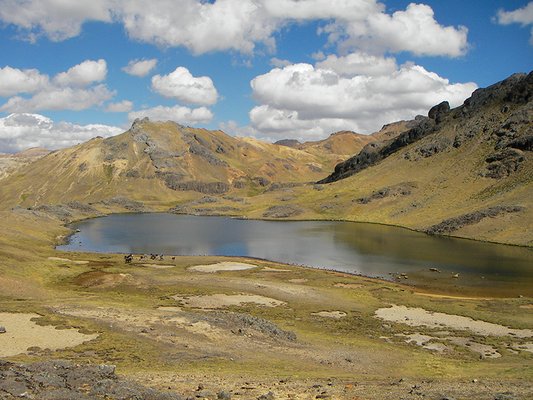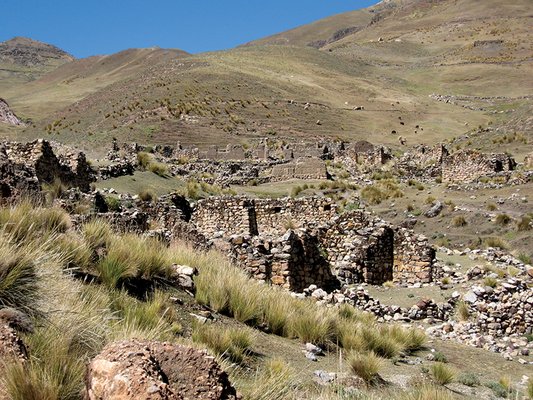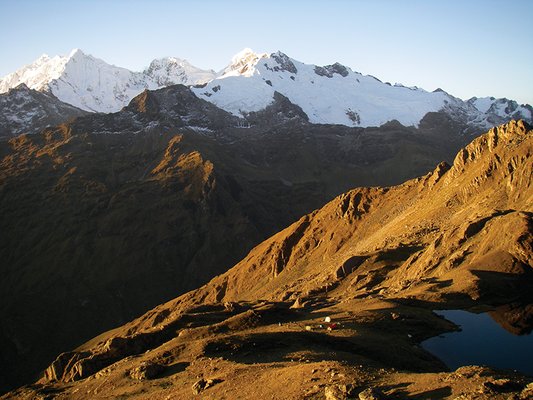
by Mary Caperton Morton Thursday, January 5, 2012

Sediments at the bottom of a small lake 4,600 meters high in the Peruvian Andes archive the history of mining and metallurgy at Huancavelica, the largest mercury deposit in the New World. William Hobbs

Colonial ruins litter the landscape around the Huancavelica mercury deposit. Colin Cooke

Laguna Warmicocha, high in the Peruvian Andes, served as base camp for researchers studying the history of mercury mining and pollution in the Andes. Alberto Reyes
The Inca knew there was something sinister about the cinnabar they hauled out of the ground at Huancavelica in Peru hundreds of years ago. They called the mine the Mine of Death. Now, a new study has exposed a 3,500-year history of mercury pollution from the cinnabar mines, a much longer legacy than researchers had previously realized.
Huancavelica, Peru, located 450 kilometers southeast of Lima, has been known as one of the world’s most abundant sources of mercury since the Spaniards assumed control of the Peruvian mines in A.D. 1564. Since then, an estimated 36,000 tons of mercury were mined from the region’s cinnabar ore until the mines were closed in 1974 due to diminishing production. But little had been known about the mine’s pre-colonial productivity.
Colin Cooke, an environmental geologist at the University of Alberta in Edmonton, Canada, and lead author of the new study published in Proceedings of the National Academy of Sciences, exhumed sediment cores from two lakes near the Huancavelica mines and one several hundred kilometers away to monitor the extent of the historic mercury pollution.
Cores from the lakes closest to the mine show evidence of mercury pollution from mining dating back as early as 1400 B.C., making these the earliest and longest-exploited mines in the Andes. The earliest people probably were not after the liquid mercury, Cooke says, but more likely ground up the cinnabar, a red mercury-sulfide ore, to make vermilion, a red pigment used for body paint and for adorning ceremonial gold objects.
According to the sediment core record, cinnabar mining at Huancavelica remained slow but steady, with mercury levels three to five times greater than the lakes’ natural pre-mining mercury content until it spiked 30 times above pre-mining background levels with the rise of the Incan empire in A.D. 1450. The first appearance of mercury pollution in sediments from Lake Negrilla, located 225 kilometers east of Huancavelica near Machu Picchu, not only record the rise of the Incan empire, but also record a shift in mercury refining techniques.
“Prior to the Inca, they were just mining the ore, grinding it up and turning it into pigment,” Cooke says. “But after the Inca moved in, they started heating the ore, which releases gaseous mercury vapors. Those vapors can be transported over very long distances.” To date, no archaeological evidence has been found to indicate that the Incas used liquid mercury, but Cooke suggests they may have used it to polish gold and silver objects.
“This is the first evidence we have that the Incas were smelting the cinnabar,” says Kendall Brown, a historian at Brigham Young University in Provo, Utah, who was not involved in the new study. “So widespread mercury pollution dates back much further than we thought. It wasn’t a problem that began with the Spaniards.” However, he says, the Spanish certainly made the problem worse: They spread the mercury pollution all over South America because they used the mercury to amalgamate silver, which they were mining elsewhere in Peru and in Bolivia.
The mercury levels recorded in the three lakes continued to rise through modern times and peaked at 105 times greater than background levels during Huancavelica’s strip mining heyday in the 1970s, just before the mine shut down, Cooke says. Today, small-scale artisanal miners continue to extract mercury from the mine in small quantities, and pollution levels are currently around five times greater than pre-mining background levels. “To my knowledge nobody has done a systematic study of the effects of mercury on the 40,000 people living in Huancavelica today,” Brown says. “But I’ve heard they have very high numbers of stillbirths, so it seems the mines will continue to affect people there for generations to come.”
© 2008-2021. All rights reserved. Any copying, redistribution or retransmission of any of the contents of this service without the expressed written permission of the American Geosciences Institute is expressly prohibited. Click here for all copyright requests.